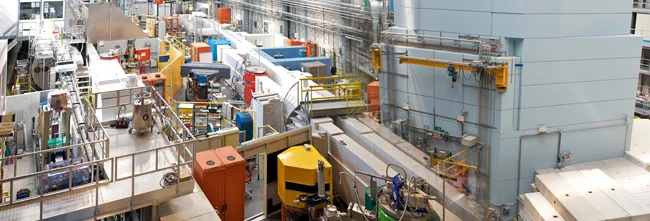The Swiss Light Source – SLS
The Swiss Light Source (SLS) at the Paul Scherrer Institut is a third-generation synchrotron light source. In the design of SLS a high priority was given to the items quality (high brightness), flexibility (wide wavelength spectrum) and stability (very stable temperature conditions) for the primary electron beam and the secondary photon beams. With an energy of 2.4 GeV, it provides photon beams of high brightness for research in materials science, biology and chemistry. (More details on www.psi.ch/sls)

The Swiss Spallation Neutron Source – SINQ
Neutron scattering is one of the most effective ways to obtain information on both, the structure and the dynamics of condensed matter. A wide scope of problems, ranging from fundamental to solid state physics and chemistry, and from materials science to biology, medicine and environmental science, can be investigated with neutrons. Aside from the scattering techniques, non-diffractive methods like imaging techniques can also be applied with increasing relevance for industrial applications.
The spallation neutron source SINQ is a continuous source - the first of its kind in the world - with a flux of about 1014 n/cm2/s. Beside thermal neutrons, a cold moderator of liquid deuterium (cold source) slows neutrons down and shifts their spectrum to lower energies. These neutrons have proved to be particularly valuable in materials research and in the investigation of biological substances. SINQ is a user facility. Interested groups can apply for beamtime on the various instruments by using the SINQ proposal system. (More details on www.psi.ch/sinq)
The spallation neutron source SINQ is a continuous source - the first of its kind in the world - with a flux of about 1014 n/cm2/s. Beside thermal neutrons, a cold moderator of liquid deuterium (cold source) slows neutrons down and shifts their spectrum to lower energies. These neutrons have proved to be particularly valuable in materials research and in the investigation of biological substances. SINQ is a user facility. Interested groups can apply for beamtime on the various instruments by using the SINQ proposal system. (More details on www.psi.ch/sinq)
